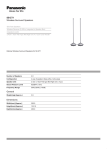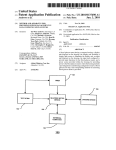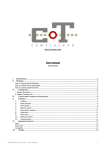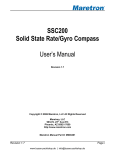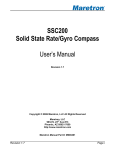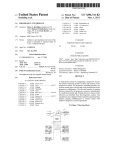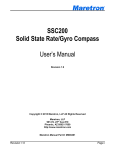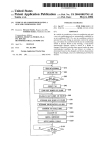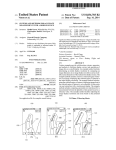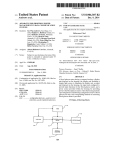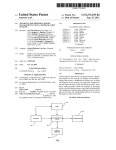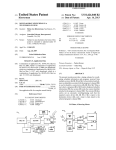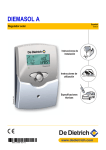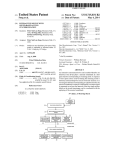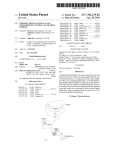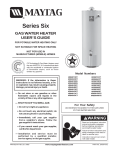Download Gyro zero turn rate offset correction over temperature in a personal
Transcript
USOO8577633B2 (12) United States Patent (10) Patent N0.: Patel (45) Date of Patent: 2008/0234935 A1 A 2009/0093984 Al : 2010/0307016 A1 PERSONAL MOBILE DEVICE (75) Inventor: _ _ KR Notice: Nov. 5, 2013 9/2008 Wolfet a1. 4/2009 6t ill. .................. .. 702/104 12/2010 Mayor et al. .................. .. 33/356 FOREIGN PATENT DOCUMENTS Parln Patel, San Francisco, CA (US) 1020040062038 (73) Assignee: Apple 1116., Cupertino, CA (US) (*) US 8,577,633 B2 7/2004 OTHER PUBLICATIONS Subject to any disclaimer, the term of this patent is extended or adjusted under 35 U.S.C. 154(b) by 750 days. “DSMZOO NMEA2000® Multi-Function Graphic Display”, User’s Manual, Revision 1.7, Copyright© 2006 Maretron, LLC, Phoenix, AZ, USA, Maretron Manual Part #: M000201, (p. i, pp. 29-30). “SSC200 Solid State Rate/Gyro Compass”, User’s Manual, Revision (21) App1_ NO; 12/794,531 1.7,Copyright© 2006,Maretron, LLC, PhoeniX,AZ, USA, Maretron Manual Part #: M000401, 43 pages. (22) Filed: Jun. 4, 2010 (65) . Prior PUblication Data Dec. 8, 2011 Primary Examiner * Jonathan C Teixeira Moffat us 2011/0301900 A1 Assistant Examiner * Hien V0 (74) Attorney, Agent, or Firm * Fish & Richardson PC. (51) Int. Cl. (57) G06F 19/00 (52) . * cited by examiner ABSTRACT (201 1.01) _ us CL _ _ _ _ A personal mobile deV1ce housing contains a display screen, USPC _______________ __ 702/72. 702 /9 4. 702/99. 702/104, a Wireless telephony communications transceiver, and a bat 702/150. 73/137. 733/177. 733/497. 73/504181 ’ ’ ’ ’ tery charger interface. Atemperature sensor anda gyro sensor 3 2 4 /1 62’ Whose zero turn rate output contains an offset are also USPC ~~~~~~~~~~~~~~~~ u 702/72, 94’ 99’ 104’ 1 50; 33/35 6; rection values associated With different temperature values.A (58) Field of Classi?cation Search included. A lookup~table has gyro zero turn rate offset cor 73/1 37 1 77 497 50 4 18 ' ’ ' ’ ’ programmed processor accesses the lookup table to correct ' the output of the gyro sensor for zero turn rate offset. It is see apphcanon ?le for complete searCh hlswry' (56) automatically determined, during in-the-?eld use, When the References Cited device is in a motionless state, and the output of the tempera ture and gyro sensors are read. The read gyro output is written U.S. PATENT DOCUMENTS 515271003 A 2002/0169553 A1 2003/0036847 A1 to the lookup table as part of a pair of associated temperature and zero tum rate offset correction values. Other embodi ments are also described and claimed. 6/1996 Diesel et 31~ 11/2002 Perlmutter et al. 2/2003 Geier et a1. 13 Claims, 5 Drawing Sheets START OBTAIN OUTPUT DATA OF MOTION SENSOR OVER A GIVEN TIME INTERVAL 36 DOES THE DATA INDICATE THE DEVICE IS MOTIONLESS? YES PERFORM SAN ITV CHECK ON THE READ GVRO DATA - OK TO WRITE TO LOOKUP 44 ,J NEW OFFSET CORRECTION VALUE (ASSOCIATED WITH A NEW TEMPERATURE VALUE] WRITE AN OFFSET cORREcTIoN VALUE To THE LOOKUP TABLE (As PART OF A PAIR OF ASSOCIATED TEMPERATURE AND ZRO CORRECTION VALUES UPDATED OFFSET CORRECTION VALU ASSOCIATED WITH A I, PRE EXISTING TEMPERATURE VE YES NEED TO UPDATE OR FURTHER POPULATE THE LOOKUF' TABLE7 US. Patent Nov. 5,2013 Sheet 1 0f5 US 8,577,633 B2 FIG.1 US. Patent Nov. 5,2013 Sheet 3 0f5 ZRO (deg/sec) FIG. 3 US 8,577,633 B2 US. Patent Nov. 5,2013 Sheet 4 0f5 US 8,577,633 B2 I START I V OBTAIN OUTPUT DATA OF MOTION SENSOR OVER A GIVEN TIME INTERVAL 34 DOES THE DATA INDICATE THE DEVICE IS MOTIONLESS? NO READ OUTPUT DATA OF TEMPERATURE SENSOR 38 I READ OUTPUT DATA OF GYRO RATE SENSOR 40 I PERFORM SANITY CHECK ON THE READ GYRO DATA - OK TO WRITE TO LOOKUP TABLE? 44 p] NEW OFFSET CORRECTION VALUE WRITE VALUEAN TOOFFSET THE LOOKUP CORRECTION TABLE (AS PART OF A PAIR OF ASSOCIATED TEMPERATURE AND ZRO CORRECTION VALUES) I UPDATED OFFSET CORRECHON \_> VALUE (ASSOCIATED WITH A PRE-EXISTING TEMPERATURE 46 VALUE; OVERWRITE OLD CORRECTION VALUE) YES NEED TO UPDATE OR FURTHER POPULATE THE LOOKUP TABLE? FIG. 4 US. Patent Nov. 5, 2013 US 8,577,633 B2 Sheet 5 0f 5 Oz $3.25 .QEm US 8,577,633 B2 1 2 GYRO ZERO TURN RATE OFFSET CORRECTION OVER TEMPERATURE IN A PERSONAL MOBILE DEVICE In accordance with an embodiment of the invention, a multi-function handheld device has a housing in which a gyro sensor and a temperature sensor have been integrated at the factory. The device also includes a programmed processor, which accesses a lookup table to correct the output of the gyro sensor for zero turn rate offset (ZRO). To populate the lookup An embodiment of the invention relates to personal mobile devices that include a gyroscope (gyro) whose zero turn rate output may contain an error (also referred to as offset or bias), table, the processor automatically determines, during in-the or compensating) for the effect of such offset over the full ?eld use of the device or “normal use” by its end user, when the device is in a motionless state. It then reads the output of operating temperature range of the device. Other embodi the temperature sensor as well as the output of the gyro sensor ments are also described. at that point, and writes the read gyro output value to the lookup table as one of a pair of associated temperature and and techniques for correcting (also referred to as calibrating ZRO correction values. The lookup table need only have been ?lled partially at the factory, using an initial calibration or testing process that can be performed relatively quickly on the device, with very few temperature data points. Once the device is in-the-?eld, however, the lookup table may be fur ther developed or populated with many more temperature BACKGROUND Gyroscopes (or gyros, where the term is generically used here to refer to angular rate, turn rate, or turn speed sensors) have been suggested to be included in consumer electronics personal mobile devices such as multi-function cellular phones and smart phones. In such a multifunction handheld portable device, the gyro may be used by applications that measure heading changes (for example, in-the-?eld of navi 20 gation) or for measuring the rate of rotation as may be needed by a video game application. The types of gyro that are practical or suitable for use in such devices include micro electromechanical system, MEMS, type vibratory gyros. A 25 MEMS vibratory gyro is particularly suitable for use in a of the personal mobile device, again without requiring a sig handheld device, because of its relatively small size, low power consumption, suitability for high volume manufacture and low cost. However, such a gyro may be particularly sensitive to temperature, in that its turn rate output signal (indicating the sensed rate at which the gyro package is rotat 30 ing about a given axis) exhibits signi?cant fabrication process variation as well as temperature variation. The gyro can be calibrated for zero rate offset during manu facturing test, as follows. The gyro is kept motionless in a 35 temperature-controlled environment. Its output is then sampled and recorded at different temperatures. This offset data is then stored in a lookup table, together with the asso ciated temperature values at which they were collected. The table is then provided with the gyro to a system manufacturer who integrates them into a personal mobile device. A calibra ni?cant amount of time calibrating the gyro during manufac turing test of the device. A further aspect of the invention lies in performing a “san ity check” for a newly read, ZRO value, before writing the value to the lookup table. Since the process for populating the lookup table is performed in-the-?eld, this may present unex pected events (in contrast to a laboratory environment that is well controlled during manufacturing test). A veri?cation process is described that checks whether the read offset value is signi?cantly different than a preexisting correction value that is in an entry of the table whose temperature value is suf?ciently close to the current temperature of the gyro. The 40 tion process in the mobile device can then periodically read a temperature sensor that may be integrated with the gyro, lookup the associated offset correction from the table, and then apply the correction to the output of the gyro. data points in a manner that is inconspicuous to its end user, as the device is subjected to the wide range of temperatures that are typically expected for such a device. The in-the-?eld learning of ZRO corrections over tempera ture may also be used to update pre-existing entries in the lookup table. The ZRO of the gyro sensor may drift or vary over time. The learning process may be used to update the table so that gyro readings remain accurate throughout the life preexisting entry may have been determined at the factory during manufacturing test. If the read gyro output is signi? cantly different than the preexisting value, then the read gyro output is likely to be incorrect or corrupted. The corruption may have occurred because of acoustic vibrations that cannot 45 be detected using the accelerometer but that nonetheless interact with a mechanical gyro sensor in a way that corrupts SUMMARY the output of the gyro sensor. The sanity check serves to prevent incorrect ZRO values in such a situation to be written The one-time calibration process described above that can be performed during the time of manufacturing test of a multi-function handheld mobile device requires not just a controlled temperature environment, but also a signi?cant period of time to test each individual specimen of the device. to the lookup table. 50 invention includes all systems and methods that can be prac ticed from all suitable combinations of the various aspects That is because a gyro that is integrated in such a device will experience a relatively wide range of temperatures during summarized above, as well as those disclosed in the Detailed 55 in-the-?eld use. Such devices are used in a wide range of ambient temperatures, e.g. indoors and outdoors, in hot weather and cold weather. In addition, the tight con?nes inside the housing of such devices coupled with power-inten sive functions being performed in them, such as music and video playback, wireless communications, and video game The above summary does not include an exhaustive list of all aspects of the present invention. It is contemplated that the Description below and particularly pointed out in the claims ?led with the application. Such combinations have particular advantages not speci?cally recited in the above summary. BRIEF DESCRIPTION OF THE DRAWINGS 60 The embodiments of the invention are illustrated by way of gyro that is also inside the housing. However, the temperature example and not by way of limitation in the ?gures of the accompanying drawings in which like references indicate range that is used for gyro calibration at the factory should be similar elements. It should be noted that references to “an” or processing, can cause a large swing in the temperature of the as short as possible, so as not to spend an inordinate amount 65 “one” embodiment of the invention in this disclosure are not of time just for testing a single function of such a multi function device, in a high volume manufacture setting. necessarily to the same embodiment, and they mean at least one. US 8,577,633 B2 4 3 For wireless telephony, a baseband processor 18 is FIG. 1 shows a human user holding different types of a multi-function handheld mobile device, namely a smart included to perform speech coding and decoding functions phone and a handheld tablet-like personal computer. upon the uplink and downlink signals, respectively, in accor dance with the speci?cations of a given protocol, e. g. cellular GSM, cellular CDMA, wireless VOIP. A cellular transceiver 19 receives the coded uplink signal from the baseband pro FIG. 2 is a block diagram of the constituent functional unit blocks and hardware components in an example multi-func tion handheld mobile device. FIG. 3 is a graph of zero turn rate offset as a function of cessor and up converts it to a carrier band before driving an temperature, for a multi-axis gyro angular rate sensor. FIG. 4 is an algorithm or process ?ow for populating and updating a gyro zero turn rate offset correction lookup table. FIG. 5 is an algorithm or process ?ow for performing a sanity check on a read, gyro zero turn rate offset value. antenna 20 with it, to reach a cellular network base station; it also receives a downlink signal from the base station via the antenna 20 and down converts the signal to baseband before passing it to the baseband processor 18. A wireless local area network transceiver 22 receives and transmits data packets from a nearby wireless router or access point, using an antenna 23. DETAILED DESCRIPTION Several embodiments of the invention with reference to the appended drawings are now explained. While numerous details are set forth, it is understood that some embodiments of the invention may be practiced without these details. In Power is provided to operate the components shown in FIG. 2 by a battery 25 (generically used here to refer to a rechargeable power source that may also include a recharge able fuel cell). The battery 25 is charged or replenished by an external power source such as a wall plug or automobile 20 other instances, well-known circuits, structures, and tech niques have not been shown in detail so as not to obscure the understanding of this description. FIG. 1 shows two instances of a multi-function handheld mobile device 2 (also referred to here as a personal mobile 25 29 and its associated interface 28 to be used for both power transfer to recharge the battery 25 and for data I/O commu device) held in the hands of an end user or owner of the device 2. In one instance, the device 2 is a smart phone or a multi function cellular phone with several features typically avail able in modern handheld wireless communication devices, such as a touch screen interface, music and video ?le record battery dc power adapter (not shown) that connects to a multi pin docking connector 29 that is also integrated in the housing of the device 2. The connector 29 and its associated charger and I/O interface circuitry 28 may be in accordance with any suitable computer peripheral speci?cation such as Universal Serial Bus (USB). The USB protocol allows for the connector nications. The latter includes docking functions, to synchro 30 nize user content in the device 2 with another computer device owned by the user that may have substantially more data ing and playback, digital camera, video games, and wireless storage capacity, e.g. a desktop computer, a laptop/notebook enabled applications such as voice over intemet protocol computer. telephony, electronic calendar, web browser, and email. In The personal mobile device 2 presents a particularly chal lenging task for dissipating su?icient heat that is produced as a result of the various functions running inside its housing. A another instance, the device 2 may be a larger, handheld tablet-like computer such as an iPadTM device by Apple Inc. 35 FIG. 2 shows a functional unit block diagram and some thermal management process is needed to make sure that critical temperature points or hot spots inside and on the constituent hardware components of the personal mobile user is a touch sensitive display screen (referred to here as a outside surface of the housing do not exceed their maximum speci?cations; the process may be conducted with help from a power management unit (PMU) 26. The PMU 26 is typi cally implemented as a programmed processor, with associ touch screen) 11. The housing may be essentially a solid ated analog and digital conversion circuitry, analog signal volume referred to as a candy bar or chocolate bar types as in the iPhone device. An alternative is one that has a moveable, multi-piece housing, such as a clamshell design, or one with needed to control or communicate with other components of device 2, e.g. as found in an iPhoneTM device by Apple Inc. Although not shown, the device 2 has a housing in which the primary mechanism for visual and tactile interaction with its 40 conditioning circuitry, and a data communications interface 45 the device 2 (for purposes of thermal management.) The PMU a sliding, physical keypad as used by other cellular and 26 obtains temperature data (or temperature readings) from mobile handset or smart phone manufacturers. The touch screen 11 is used to display typical features of visual voice multiple temperature sensors, as well as power data (sensed or estimated power consumptions of certain power-hungry components), and then processes that data to make decisions mail, web browser, email, and digital camera view?nder, as well as others, and to receive input from the user via virtual buttons and touch commands. For wireless telephony, which enables the user to receive 50 and place audio and/or video calls, downlink audio during a call can be emitted from a speaker 13 (which may be an earpiece speaker or receiver, or it may be a headset earphone). Uplink audio includes the user’s speech, which is picked up by a microphone 16 (e.g., mouthpiece microphone or headset microphone). Conversion between analog domain and digital domain for the speaker and microphone signals, in addition to digital audio signal processing for different applications run ning in the device 2, may be performed within audio codec 17. A physical volume switch or button 15 may also be connected to the codec. The codec 17 may be con?gured to operate in different modes, e. g. to service a digital media player function (such as an MP3 player that is playing back a music ?le that is stored in the device 2), as well as a wireless telephony function. 55 that affect power consumption activity, in order to maintain speci?ed thermal levels or temperature constraints for the device 2. For instance, if the back case of the device 2 is becoming too hot, then the PMU may decide to take any one or more several actions, including turning on a fan inside the device 2 to more quickly pull the hot air from inside the device 2, lowering the maximum output power of ampli?ers used for audio playback and cellular transmission, and lowering the supply voltage and/ or main clock signal frequency of a large processor. The PMU 26 may also include power supply cir 60 cuitry with various regulated voltage outputs for supplying power to the components of the device 2. The PMU 26 may also be tasked with the orderly powering down and powering 65 up the various components of the device 2, in response to system reset or the main power on/off switch 27 being actu ated by the user. The device 2 also includes a motion sensor 7 which may use an accelerometer to measure linear acceleration of the US 8,577,633 B2 5 6 device 2 along a given axis. A gyro sensor 3 may use a MEMS type mechanical vibratory gyroscope to measure turn rate or The algorithm may begin with the programmed processor automatically determining, during in-the-?eld use of the per angular velocity of the device 2 about a given axis. A tem sonal mobile device 2, that the device is in a motionless state. perature sensor 5 may use a thermistor to measure tempera This is depicted in blocks 34 and 36 where output data of the ture of the gyro sensor 3. The temperature sensor 5 may be integrated with the gyro sensor 3 on the same integrated motion sensor 7 is obtained over a given time interval. For example, samples from the output of an accelerometer may be taken for several seconds, and if the average of these samples circuit die or alternatively in the same integrated circuit pack is less than a selected threshold, such as 2% of what represents a motionless state (namely zero acceleration), then the data age. The user-level functions of the device 2 are implemented under control of a processor 6 that has been programmed in indicates that the device is motionless such that operation may continue with reading the output of the temperature accordance with instructions (code and data) stored in sensor (block 38) and the output of the gyro turn rate sensor (block 40). Note also that in blocks 38 and 34 as part of the sensor readout operation, a smoothing function may be memory 4. The processor 6 and memory 4 are generically used here to refer any suitable combination of programmable data processing components and data storage that conduct the operations needed to implement the various functions of the device. The processor 6 may be an applications processor typically found in a smart phone, while the memory 4 may refer to microelectronic, non-volatile random access memory. An operating system may be stored in the memory 4, applied to a short sequence of raw output values from the sensors to obtain a single, representative value. For instance, the actual output data that is evaluated or used in a subsequent operation below may be an average of several samples taken 20 along with application programs speci?c to the various func from the respective sensor, so as to smooth out the effects of noise in instantaneous readings from the sensors, or to ensure that the raw values are reasonably stable before using them. tions of the device, which are to be run or executed by the Next, skipping to operation 44, the read gyro output is processor 6 to perform the various functions of the device 2. written to the lookup table 9 as an offset correction value, as For instance, there may be a telephony application that (when launched, unsuspended, or brought to foreground) enables part of a pair of associated temperature and ZRO correction 25 values. If the gyro output value is associated with a new the user to “dial” a telephone number to initiate a telephone temperature value, that is, one not previously existing in the call using wireless VOIP or a cellular protocol and to “hang up” on the call when ?nished. As explained above, certain types of gyro sensors exhibit strong variation in their ZRO with temperature, and thus need table, then this is considered a new offset correction value and is therefore written into a new entry (together with the tem 30 perature value that was read in block 38). On the other hand, if the temperature value from block 38 matches a preexisting ture range. FIG. 3 is a graph of ZRO as a function of expected temperature value in the lookup table, then operation 44 essentially updates or overwrites the old ZRO correction operating temperature range, for an example multi-axis mechanical gyro. A corrected gyro reading can be obtained by value of that entry in the table 9. The process then may repeat with blocks 34-44, if there is a need to update or further to be corrected across their full, expected operating tempera subtracting the ZRO (that is speci?ed for the current gyro temperature) from the current gyro output. The processor 6 35 populate the entries in the lookup table. For instance, the process in FIG. 4 may be repeated each time a signi?cant period of time has elapsed since the table 9 was deemed to be may be programmed in accordance with a gyro ZRO correc tor program module 8 (which may be stored in the memory 4), complete, so as to ensure that any drifts or variations in the to achieve such a result. gyro sensor 3 are recaptured and corrected. The process may Still referring to FIG. 2, the ZRO corrector 8 produces corrected gyro readings as follows. Speci?cally, the proces 40 coverage for the full, expected operating temperature range of sor 6 is programmed to read the outputs of the gyro sensor 3 and the temperature sensor 5 within a relatively short time interval of each other, to determine gyro output at a particular temperature. A lookup table 9 stored in the device 2, e. g. in the the gyro sensor 3. Still referring to FIG. 4, the programmed processor 6 may 45 block 42 is not necessary in all instances, it does help prevent to ?nd a ZRO correction value associated with that tempera ture. For example, as seen in FIG. 2, if the temperature sensor 5 shows 10.7+/—0.2 Celsius, then the ZRO correction value to Ideally, lookup table 9 should be ?lled, as depicted in the graph of FIG. 3, with temperature and ZRO values spanning the entire expected operating temperature range of the gyro and in suf?ciently ?ne granularity. However, as explained below, this may not be practical at the time of manufacturing also perform a sanity check on a read gyro output, before deciding it is proper to write it to the lookup table as a new or updated correction value (block 42). While the operation in memory 4, is then accessed using the particular temperature, be applied to the read gyro output is —3.0 degrees/ sec. The corrected gyro output value may then be passed to an appli cation that needs to know the current angular velocity of the device 2 with good accuracy. also be triggered when the table 9 does not yet have suf?cient 50 the table 9 from being populated with possibly corrupt values or clearly incorrect values, especially since the process of FIG. 4 is being performed in-the-?eld essentially inconspicu ous to the end user, and thus may be subject to unexpected events that could interfere with operation of the gyro sensor. If the sanity check is cleared, then operation proceeds with block 44 as described above, to write to the table 9. If, how 55 ever, the sanity check indicates a problem, then one or more of the prior operations depicted in FIG. 4 should be repeated. For instance, the output data of the gyro rate sensor may be re-sampled through operation 40 and subjected to the sanity test of the device 2. The device 2 may be shipped from its factory with the lookup table 9 only partially ?lled. For check again, to make sure that an incorrect offset correction value is not written to the table 9. FIG. 5 shows an algorithm example, the table 9 may initially contain only a few entries. This allows the device 2 to pass through manufacturing test more quickly. Once in-the-?eld, however, the ZRO corrector 8 may be used to advantageously program the processor 6 to automatically populate the table 9 with many more entries, while remaining inconspicuous to the end user. FIG. 4 shows for the sanity check process. Referring to FIG. 5, operation begins with block 52 in which the read temperature and gyro outputs are compared to preexisting temperature and offset correction pairs in the table 9, to determine whether the read gyro output value is signi?cantly different than a pre-existing correction value an algorithm for such a process. 65 that is associated with a temperature value that is close to the US 8,577,633 B2 7 8 read or current temperature. In one case, the comparison is made with a preexisting pair that was written to the table 9 in While certain embodiments have been described and shown in the accompanying drawings, it is to be understood that such embodiments are merely illustrative of and not restrictive on the broad invention, and that the invention is not limited to the speci?c constructions and arrangements shown and described, since various other modi?cations may occur to those of ordinary skill in the art. The description is thus to be regarded as illustrative instead of limiting. the factory. In other words, the in-the-?eld ZRO value is checked against a ZRO correction value that was determined at the factory during a manufacturing test, for example, that was under well-controlled conditions (resulting in correct gyro values). If the in-the-?eld read gyro output is signi?cantly different than a preexisting value from the table 9, then operation may proceed with block 56 to determine whether the in-the-?eld What is claimed is: 1. A personal mobile device comprising: a multi-function handheld portable device housing in which are integrated read temperature and gyro outputs are close enough to an estimated pair. This may be the situation where a new tem perature is quite different than those already in the table 9. An interpolation or extrapolation procedure may be performed to a display screen; a wireless communications transceiver; determine an estimate of ZRO, for instance based on the a battery charger interface; preexisting data in the table 9, at the new temperature value. If the read gyro output is not close enough to the estimated value, then it is likely that the read gyro output is incorrect or corrupted, in which case it should not be written to the lookup table (block 58). This corresponds to the situation where for a temperature sensor; a movement sensor that generates data indicative of linear movement of the device; 20 instance there may have been interference due to acoustic vibrations in the device 2 that may not have been picked up by the motion sensor 7, but that nevertheless interact with the of containing an offset; storage that stores a plurality of gyro zero turn rate offset correction values associated a plurality of different tem perature values, respectively; and mechanical structure of the gyro sensor 3 to corrupt the gyro output. It may be, for instance, that an acoustic vibration at approximately the mechanical resonant frequency of the gyro sensor 3 is occurring during readout, where such acoustic vibrations may have been created by sound emitted from a built-in speaker of the device 2. This could be the situation where the user has placed the device 2 on a table (such that the device is motionless), but has turned on the digital media a gyro sensor having a zero turn rate output that is capable 25 a programmed processor to access the plurality of gyro zero turn rate offset correction values for correcting an output value of the gyro sensor for zero turn rate offset, wherein the programmed processor is to (a) automatically determine, during in-the-?eld use of the 30 personal mobile device, when the device is in a motion less state by determining when output from the move player application and the latter is playing music through the ment sensor remains within a predetermined zero built-in speakerphone or loudspeaker of the device 2. In that situation, the process in FIG. 5 will detect that there is a problem with the gyro zero rate output and therefore ignore that value (for purposes of updating or writing to the lookup threshold range for a predetermined time interval and (b) based on gyro sensor output, add a zero turn rate offset 35 table). correction value to the plurality of gyro zero turn rate offset correction values as a part of a pair of associated temperature and zero turn rate offset correction values. Still referring to FIG. 5, and returning to operation 52, if the 2. The mobile device of claim 1 wherein the programmed read temperature and gyro outputs are close enough to a processor is to repeatedly perform (a)-(b), during in-the-?eld preexisting temperature and offset correction value pair, then 40 use of the device, as the device encounters a range of different a decision should be made next as to whether the preexisting temperatures. pair in the table 9 needs to be updated or overwritten (opera tion 54). For instance, each entry in the lookup table may be tagged with a date, such that if an entry is deemed to be old, sensor and the gyro sensor are integrated in the same inte then it should be updated or overwritten with a new reading. In that case, the process in FIG. 5 indicates that the current or 3. The mobile device of claim 1 wherein the temperature grated circuit package. 45 4. The mobile device of claim 1 wherein the movement sensor is an accelerometer that generates data indicative of linear acceleration of the device. 5. The mobile device of claim 1 wherein the programmed read temperature and gyro output values should be written to the lookup table (operation 59). The latter result is also obtained if, returning now to operation 56, the read gyro processor is to, prior to adding the offset correction value, output is close enough to an estimated ZRO correction value. 50 Finally, there may be instances where the read temperature and gyro outputs so closely match a preexisting pair in the lookup table that there is no need to update the tableithis result is indicated in operation 57. As explained above, an embodiment of the invention may 55 determine if a read gyro output is within an expected range for zero turn rate offset, ZRO, wherein the expected ZRO range is computed based on one or more pre-existing pairs of associ ated temperature and zero rate offset correction values in the storage. be a machine-readable medium (such as microelectronic 6. The mobile device of claim 1 wherein the programmed processor is to, prior to adding the offset correction value, memory) having stored thereon instructions, which program estimate a zero rate offset correction value associated with a one or more data processing components (generically referred to here as a “processor”) to perform the gyro and read output of the temperature sensor, based on pre-existing data stored in the device that describes variation of the gyro temperature sensor output data processing operations described above, including reading from and writing to a 60 value. ZRO correction lookup table. In other embodiments, some of these operations might be performed by speci?c hardware components that contain hardwired logic (e.g., dedicated state machines). Those operations might alternatively be per formed by any combination of programmed data processing components and ?xed hardwired circuit components. sensor’s zero rate offset over temperature, and then compares a read gyro output to the estimated zero rate offset correction 7. A personal mobile device comprising: a gyro sensor having a zero turn rate output that is capable 65 of containing an offset; an accelerometer that generates data indicative of linear acceleration of the device; US 8,577,633 B2 10 10. A method for operating a personal mobile device hav ing a gyro sensor, comprising: correcting an output of a gyro sensor in the device by accessing a plurality of storage entries some of which were stored during manufacturing test of the device, wherein each entry includes a different temperature storage containing a plurality of initial entries that were written to the storage during manufacturing test of the device, wherein each entry includes a different tempera ture value and a respective gyro zero turn rate offset correction value; and a programmed processor to access the storage to correct an output of the gyro sensor for zero turn rate offset, wherein the programmed processor is to add a plurality of new entries to the storage during in-the-?elduse of the device, wherein for each new entry the programmed processor is to (a) automatically determine that the device is in a motionless state by determining when output from the accelerometer remains within a prede value and a respective gyro zero turn rate offset correc tion value; and 10 determining when output from a motion sensor remains within a predetermined zero threshold range for a predetermined time interval and termined zero threshold range for a predetermined time interval, and (b) based on gyro sensor output, add a zero turn rate offset correction value to the storage as part of a pair of associated temperature and zero turn rate offset correction values included in the new entry. adding a zero turn rate offset correct value, based on gyro sensor output, as part of a pair of associated temperature and zero turn rate offset correction values included in the new entry. 11. The method of claim 10 further comprising: 8. The mobile device of claim 7 wherein the programmed processor is to verify a gyro output before adding a zero turn 20 values stored in the table. 12. The method of claim 10 further comprising: gyro output to a pre-existing offset correction value in the storage. 9. The mobile device of claim 7 wherein the programmed ture, and wherein the programmed processor is to, before adding a zero turn rate offset correction value to the storage compare a gyro output to the estimated offset correction value. before adding a zero turn rate offset correction value, com paring a gyro value to one or more offset correction rate offset correction value to the storage, by comparing the processor is to compute an estimated offset correction value that is associated with the temperature of the gyro sensor, based on previously stored data in the device that describes variation of the gyro sensor’s zero rate offset over tempera adding a plurality of new entries to the storage during in-the-?eld use of the device, by, for each new entry, determining that the device is in a motionless state by 25 before adding a zero turn rate offset correction value, com paring a gyro value to an estimated offset correction value that is associated with a determined temperature of the gyro sensor. 30 13. The method of claim 12 further comprising: computing the estimated offset correction value based on previously stored data in the device that describes varia tion of the gyro sensor’s zero rate offset over tempera ture. UNITED STATES PATENT AND TRADEMARK OFFICE CERTIFICATE OF CORRECTION PATENT N0. : 8,577,633 B2 APPLICATION NO. DATED : 12/794531 : November 5, 2013 INVENTOR(S) : Parin Patel Page 1 of 1 It is certified that error appears in the above-identi?ed patent and that said Letters Patent is hereby corrected as shown below: In the Claims In Claim 1, column 8, line 23, after “associated” insert -- With --. In Claim 9, column 9, line 31, delete “storage” and insert -- storage, --. In Claim 10, column 10, line 15, delete “correct” and insert -- correction --. Signed and Sealed this Seventeenth Day of June, 2014 WMZ44L_ Michelle K. Lee Deputy Director 0fthe United States Patent and Trademark O?ice












